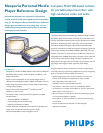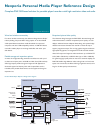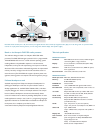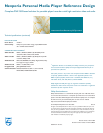
Download media content from a PC, the Internet, even digital still and video cameras for enjoyment later (left); use in the living room as a personal video
recorder or to play stored movies, pictures, or music using home theatre display and speakers (right).
INTERNET
music
video
at school
e
=
mc
2
on the train
in the
kitchen
PC
TV
TV
HOME THEATRE
REFERENCE DESIGN
Hardware PNX1500-based reference board, miniPCI daughter
card housing 802.11 a/b/g transceiver
Display 5-inch, transflective, switchable,VGA (640 x 480)
with touch panel
Software LCD drivers, audio/video drivers, HDD file system,
demo applications
Documentation User Guide, schematics, Gerber files
REFERENCE BOARD
Media processor PNX1501, 266-MHz TriMedia CPU
Memory 64 MB DDR SDRAM (2x32)
8 MB NAND Flash
PCI/XIO bus 32-bit, 33-MHz
Hard disk 1.8-in, 30-GB HDD with glueless IDE interface
Portable Flash Memory Stick and CompactFlash; other formats via
expansion bus
TV codec Philips SAA7108; encodes up to 800 x 600 resolu-
tion PAL or NTSC; decodes PAL, NTSC, SECAM
Audio codec Philips UDA1380 stereo codec
Connectivity Philips ISP1583 USB 2.0 Hi-speed device
Philips ISP1362 USB OTG host/device controller
(mini AB connector)
Audio input mini-jack line in (from microphone)
output mini-jack line out,headphone out, SPDIF out
Video I/O input CVBS/S-Video
output CVBS/S-Video, component video (YPbPr or
RGB)
Display I/O 18-bit, RGB LCD interface
User interface 8-bit microcontroller for keyboard/keypad
Power power management unit Philips PCF50606 PMU+
supply voltage 3.3 V I/O
battery 3.7 V 3600-mAh Varta PolyFlex
DC/DC converter Philips TEA1211
Technical specificationsBased on the Nexperia PNX1500 media processor
The reference design is based on a Nexperia PNX1500 media
processor.The PNX1500 leverages a powerful C/C++ programmable
TriMediaTM3260 CPU and runs a small real-time operating system
enabling efficient and predictable response to real-time events.
Independent, on-chip, I/O and coprocessing units capture and format
datastream I/O and accelerate multimedia algorithms. A sophisticated
memory hierarchy manages internal I/O and streamlines access to
external memory.The PNX1500 also supports dynamic power man-
agement,lowering power consumption and conserving battery charge.
Software/development tools
Available separately from Philips, the Nexperia Development Kit
(NDK) gives developers a full suite of system software tools to
develop applications for the PNX1500’s TriMedia CPU. It includes a
compiler, debugger, A/V drivers, and example software.This compre-
hensive software development environment dramatically lowers
costs and reduces time-to-market by enabling development of multi-
media applications entirely in the C and C++ programming languages.
Application libraries for the PNX1500 are available from Philips and
third parties; for a complete, up-to-date list, visit:
www.semiconductors.philips.com/nexperia/application-libraries.






